Regions Subject to Rainfall Oscillation in the 5–10 Year Band
Abstract
:1. Introduction
2. Materials and Methods
2.1. Highlighting Continental Regions Subject to Rainfall Oscillation in the 5–10 Year Band
- The series must be long enough to represent the rainfall oscillation knowing that its amplitude varies a lot over time, even disappearing during periods of lull.
- Since the average annual rainfall height is not relevant in our analysis, rainfall is reduced, that is, divided by the mean rainfall height. Being dimensionless, the temporal variations of reduced rainfall are homogenized on a global scale: this way the amplitude of the wavelet power only depends on the relative amplitude of the oscillation.
2.2. The Temporal Reference (TR)
2.3. Random Errors
2.4. Highlighting SST Anomalies Subject to an Oscillation in the 5–10 Year Band
2.5. Cross-Wavelet and Complex Empirical Orthogonal Function (EOF) Analyses
2.6. Data
3. Results
3.1. Regions Subject to the RRH Oscillation in the 5–10 Year Band in the Tropics
3.2. Regions Subject to the RRH Oscillation in the 5–10 Year Band at Mid-Latitudes
3.2.1. Rossby Waves in the Oceans at Mid-Latitudes
3.2.2. Heat Transfer from the Oceans to the Continents
3.2.3. Subtropical Depressions and Extra-Tropical Cyclones at Mid-Latitudes
3.2.4. Northeastern Pacific
3.2.5. Southwestern North America
3.2.6. Texas
3.2.7. Southeastern North America
3.2.8. Northeastern North America
3.2.9. Southern Greenland
3.2.10. Rainfall Oscillation in Europe and Western-Central Asia
3.2.11. Region of the Rio de la Plata
3.2.12. South-Western and South-Eastern Australia
3.2.13. South-Eastern Asia
4. Discussion
Acknowledgments
Conflicts of Interest
References
- Kapala, A.; Mächel, H.; Flohn, H. Behaviour of the centres of action above the Atlantic since 1881. Part II: Associations with regional climate anomalies. Int. J. Climatol. 1998, 18, 23–36. [Google Scholar] [CrossRef]
- Baines, P.G.; Folland, C.K. Evidence for a rapid global climate shift across the late 1960s. J. Clim. 2007, 20, 2721–2744. [Google Scholar] [CrossRef]
- Pokrovsky, O.M. European rain rate modulation enhanced by changes in the NAO and atmospheric circulation regimes. Comput. Geosci. 2009, 35, 897–906. [Google Scholar] [CrossRef]
- Rodó, X.; Baert, E.; Comin, F.A. Variations in seasonal rainfall in Southern Europe during the present century: Relationships with the North Atlantic Oscillation and the El Niño-Southern Oscillation. Clim. Dyn. 1997, 13, 275–284. [Google Scholar] [CrossRef]
- Brandimarte, L.; Di Baldassarre, G.; Bruni, G.; D’Odorico, P.; Montanari, A. Relation Between the North-Atlantic Oscillation and Hydroclimatic Conditions in Mediterranean Areas. Water Resour. Manag. 2011, 25, 1269–1279. [Google Scholar] [CrossRef]
- Munoz-Díaz, D.; Rodrigo, F.S. Impacts of the North Atlantic Oscillation on the probability of dry and wet winters in Spain. Clim. Res. 2004, 27, 33–43. [Google Scholar] [CrossRef]
- Santos, J.A.; Corte-Real, J.; Leite, S.M. Weather regimes and their connection to the winter rainfall in Portugal. Int. J. Climatol. 2005, 25, 33–50. [Google Scholar] [CrossRef]
- Millán, M.M.; Estrela, M.J.; Miró, J. Rainfall components: Variability and spatial distribution in a Mediterranean area (Valencia region). J. Clim. 2005, 18, 2682–2705. [Google Scholar] [CrossRef]
- Gallego, M.C.; García, J.A.; Vaquero, J.M. The NAO signal in daily rainfall series over the Iberian Peninsula. Clim. Res. 2005, 29, 103–109. [Google Scholar] [CrossRef]
- Barrera, A.; Barriendos, M.; Llasat, M.C. Extreme flash floods in Barcelona County. Adv. Geosci. 2005, 2, 111–116. [Google Scholar] [CrossRef]
- Andreo, B.; Jiménez, P.; Durán, J.J.; Carrasco, F.; Vadillo, I.; Mangin, A. Climatic and hydrological variations during the last 117–166 years in the south of the Iberian Peninsula, from spectral and correlation analyses and continuous wavelet analyses. J. Hydrol. 2006, 324, 24–39. [Google Scholar] [CrossRef]
- Luque-Espinar, J.A.; Chica-Olmo, M.; Pardo-Igúzquiza, E.; García-Soldado, M.J. Influence of climatological cycles on hydraulic heads across a Spanish aquifer. J. Hydrol. 2008, 354, 33–52. [Google Scholar] [CrossRef]
- Lorenzo, M.N.; Taboada, J.J.; Gimeno, L. Links between circulation weather types and teleconnection patterns and their influence on precipitation patterns in Galicia (NW Spain). Int. J. Climatol. 2008, 28, 1493–1505. [Google Scholar] [CrossRef]
- Lopez-Bustins, J.-A.; Martin-Vide, J.; Sanchez-Lorenzo, A. Iberia winter rainfall trends based upon changes in teleconnection and circulation patterns. Glob. Planet. Chang. 2008, 63, 171–176. [Google Scholar] [CrossRef]
- Delitala, A.M.S.; Cesari, D.; Chessa, P.A.; Ward, M.N. Precipitation over Sardinia (Italy) during the 1946–1993 rainy seasons and associated large-scale climate variations. Int. J. Climatol. 2000, 20, 519–541. [Google Scholar] [CrossRef]
- Cislaghi, M.; De Michele, C.; Ghezzi, A.; Rosso, R. Statistical assessment of trends and oscillations in rainfall dynamics: Analysis of long daily Italian series. Atmos. Res. 2005, 77, 188–202. [Google Scholar] [CrossRef]
- Dixon, H.; Lawler, D.M.; Shamseldin, A.Y. Streamflow trends in western Britain. Geophys. Res. Lett. 2006, 33, L19406. [Google Scholar] [CrossRef]
- Hannaford, J.; Marsh, T.J. High-flow and flood trends in a network of undisturbed catchments in the UK. Int. J. Climatol. 2008, 28, 1325–1338. [Google Scholar] [CrossRef]
- Kiely, G. Climate change in Ireland from precipitation and streamflow observations. Adv. Water Resour. 1999, 23, 141–151. [Google Scholar] [CrossRef]
- Massei, N.; Durand, A.; Deloffre, J.; Dupont, J.P.; Valdes, D.; Laignel, B. Investigating possible links between the North Atlantic Oscillation and rainfall variability in Northwestern France over the past 35 years. J. Geophys. Res. D Atmos. 2007, 112, D09121. [Google Scholar] [CrossRef]
- Massei, N.; Laignel, B.; Deloffre, J.; Mesquita, J.; Motelay, A.; Lafite, R.; Durand, A. Long-term hydrological changes of the Seine River flow (France) and their relation to the North Atlantic Oscillation over the period 1950–2008. Int. J. Climatol. 2010, 30, 2146–2154. [Google Scholar] [CrossRef]
- Pinault, J.L. Global warming and rainfall oscillation in the 5–10 yr band in Western Europe and Eastern North America. Clim. Chang. 2012, 114, 621–650. [Google Scholar] [CrossRef]
- Wang, C.; Enfield, D.B.; Lee, S.-K.; Landsea, C.W. Influences of the Atlantic warm pool on western hemisphere summer rainfall and Atlantic hurricanes. J. Clim. 2006, 19, 3011–3028. [Google Scholar] [CrossRef]
- Wang, C.; Lee, S.-K.; Enfield, D.B. Climate response to anomalously large and small Atlantic warm pools during the summer. J. Clim. 2008, 21, 2437–2450. [Google Scholar] [CrossRef]
- Hu, Q.; Feng, S. Variation of the North American summer monsoon regimes and the Atlantic multidecadal oscillation. J. Clim. 2008, 21, 2371–2383. [Google Scholar] [CrossRef]
- Collins, M. Evidence for Changing Flood Risk in New England Since the Late 20th Century. J. Am. Water Resour. Assoc. 2009, 45, 279–290. [Google Scholar] [CrossRef]
- Massei, N.; Laignel, B.; Rosero, E.; Motelay, A.; Deloffre, J.; Yang, Z.-L.; Rossi, A. A wavelet approach to the intra-annual to pluridecennal variability of streamflow in the Mississippi river basin from 1934 to 1998. Int. J. Climatol. 2011, 31, 31–43. [Google Scholar] [CrossRef]
- Pinault, J.-L.; Amraoui, N.; Golaz, C. Groundwater-induced flooding in macropore-dominated hydrological system in the context of climate changes. Water Resour. Res. 2005, 41, W05001. [Google Scholar] [CrossRef]
- Weng, H.; Lau, K.-M. Wavelets, period doubling, and time-frequency localization with application to organization of convection over the tropical western Pacific. J. Atmos. Sci. 1994, 51, 2523–2541. [Google Scholar] [CrossRef]
- Gu, D.; Philander, S.G.H. Secular changes of annual and interannual variability in the Tropics during the past century. J. Clim. 1995, 8, 864–876. [Google Scholar] [CrossRef]
- Wang, B.; Wang, Y. Temporal structure of the Southern Oscillation as revealed by waveform and wavelet analysis. J. Clim. 1996, 9, 1586–1598. [Google Scholar] [CrossRef]
- Gamage, N.; Blumen, W. Comparative analysis of low level cold fronts: Wavelet, Fourier, and empirical orthogonal function decompositions. Mon. Weather Rev. 1993, 121, 2867–2878. [Google Scholar] [CrossRef]
- Baliunas, S.; Frick, P.; Sokoloff, D.; Soon, W. Time scales and trends in the central England temperature data (1659–1990): A wavelet analysis. Geophys. Res. Lett. 1997, 24, 1351–1354. [Google Scholar] [CrossRef]
- Meyers, S.D.; Kelly, B.G.; O’Brien, J.J. An introduction to wavelet analysis in oceanography and meteorology: With application to the dispersion of Yanai waves. Mon. Weather Rev. 1993, 121, 2858–2866. [Google Scholar] [CrossRef]
- Liu, P.C. Wavelet spectrum analysis and ocean wind waves. In Wavelets in Geophysics; Foufoula-Georgiou, E., Kumar, P., Eds.; Academic Press: Cambridge, MA, USA, 1994; pp. 151–166. [Google Scholar]
- Farge, M. Wavelet transforms and their applications to turbulence. Annu. Rev. Fluid Mech. 1992, 24, 395–457. [Google Scholar] [CrossRef]
- Torrence, C.; Compo, G.P. A practical guide for wavelet analysis. Bull. Am. Meteorol. Soc. 1998, 79, 61–78. [Google Scholar] [CrossRef]
- Extended Reconstructed Sea Surface Temperatures, Version 3 (ERSST.v3) from the National Oceanic and Atmospheric Administration (NOAA). Available online: http://www.emc.ncep.noaa.gov/research/cmb/sst_analysis/ (accessed on 1 September 2017).
- Monthly Rainfall Data from the Climatic Research Unit (CRU). Available online: http://badc.nerc.ac.uk/data/cru/ (accessed on 1 September 2017).
- Monthly Southern Oscillation Index from the National Centre for Atmospheric Research (NCAR). Available online: http://www.cgd.ucar.edu/cas/catalog/climind/soi.html (accessed on 1 September 2017).
- Okoola, R.E.; Ambenje, P.G. Transition from the Southern to the Northern Hemisphere summer of zones of active convection over the Congo Basin. Meteorol. Atmos. Phys. 2003, 84, 255–265. [Google Scholar] [CrossRef]
- Washington, R.; James, R.; Pearce, H.; Pokam, W.M.; Moufouma-Okia, W. Congo Basin rainfall climatology: Can we believe the climate models? Philos. Trans. R. Soc. B 2013, 368, 20120296. [Google Scholar] [CrossRef] [PubMed]
- Todd, M.C.; Washington, R. Climate variability in central equatorial Africa: Influence from the Atlantic sector. Geophys. Res. Lett. 2004, 31, 203–218. [Google Scholar] [CrossRef]
- Okumura, Y.; Xie, S.P. Some overlooked features of tropical Atlantic climate leading to a new Nino-Like phenomenon. J. Clim. 2006, 19, 5859–5874. [Google Scholar] [CrossRef]
- Balas, N.; Nicholson, S.E.; Klotter, D. The relationship of rainfall variability in West Central Africa to sea-surface temperature fluctuations. Int. J. Climatol. 2007, 27, 1335–1349. [Google Scholar] [CrossRef]
- Dezfuli, A.K.; Nicholson, S.E. The relationship of rainfall variability in western equatorial Africa to the tropical oceans and atmospheric circulation. Part II: The boreal autumn. J. Clim. 2013, 26, 66–84. [Google Scholar] [CrossRef]
- Nicholson, S.E.; Dezfuli, A.K. The relationship of rainfall variability in western equatorial Africa to the tropical oceans and atmospheric circulation. Part I: The boreal spring. J. Clim. 2013, 26, 45–65. [Google Scholar] [CrossRef]
- Gill, A.E. Atmosphere–Ocean Dynamics; International Geophysics Series, 30; Academic Press: Cambridge, MA, USA, 1982; p. 662. [Google Scholar]
- Pinault, J.L. Long wave resonance in tropical oceans and implications on climate: The Pacific Ocean. Pure Appl. Geophys. 2015, 173, 2119–2145. [Google Scholar] [CrossRef]
- Cipollini, P.; Cromwell, D.; Quartly, G.D.; Challenor, P.G. Chapter 6 Remote sensing of oceanic extratropical Rossby waves. Elsevier Oceanogr. Ser. 2000, 63, 99–123. [Google Scholar] [CrossRef]
- Pinault, J.L. Long wave resonance in tropical oceans and implications on climate: The Atlantic Ocean. Pure Appl. Geophys. 2013, 170, 1913–1930. [Google Scholar] [CrossRef]
- Explain with Realism Climate Variability. Available online: http://climatorealist.neowordpress.fr/resonant-rainfall-oscillation/ (accessed on 11 June 2015).
- Pinault, J.L. Modulated response of subtropical gyres: Positive feedback, subharmonic modes, resonant solar and orbital forcing. Ocean Dyn. 2018. submitted for publication. [Google Scholar]
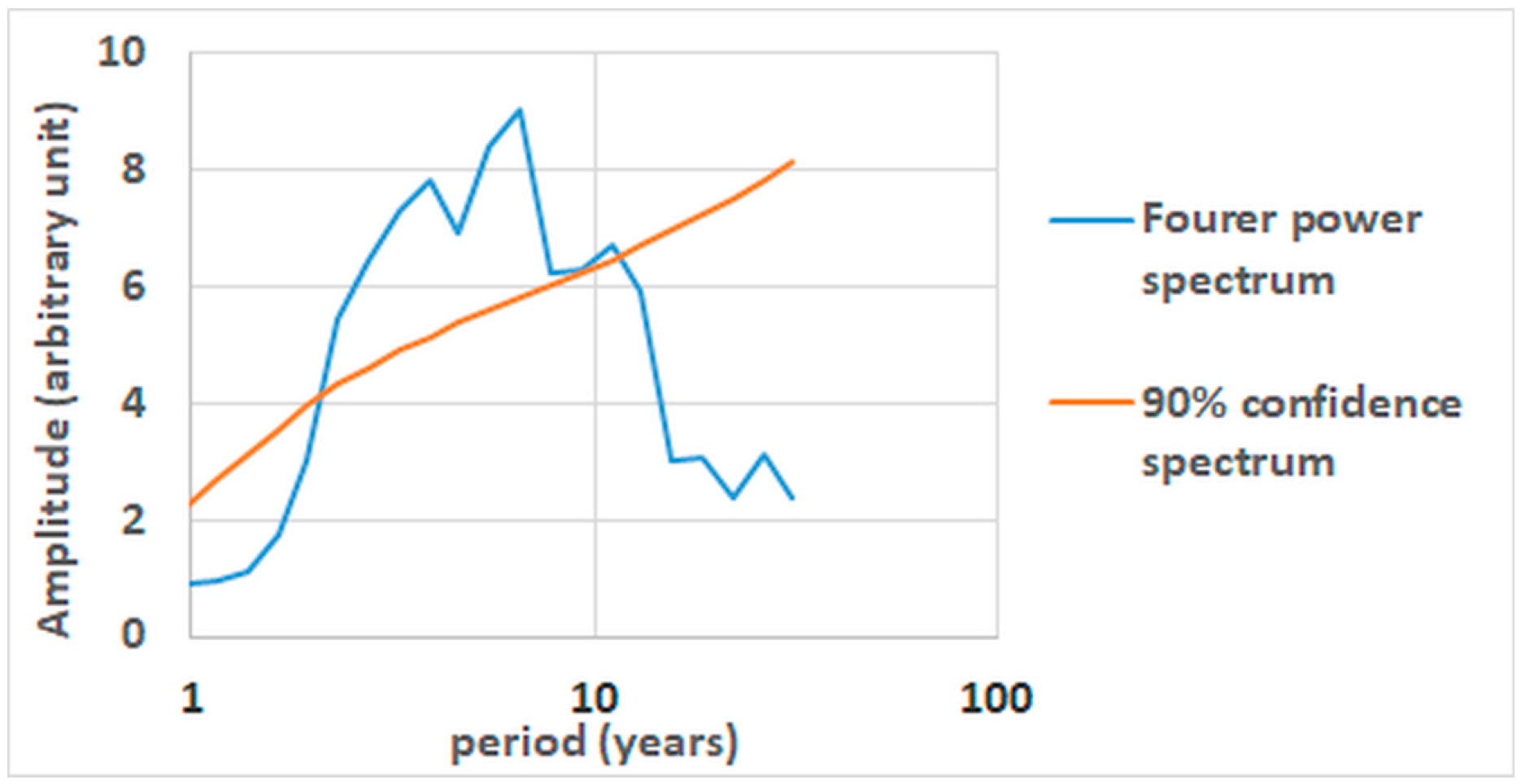
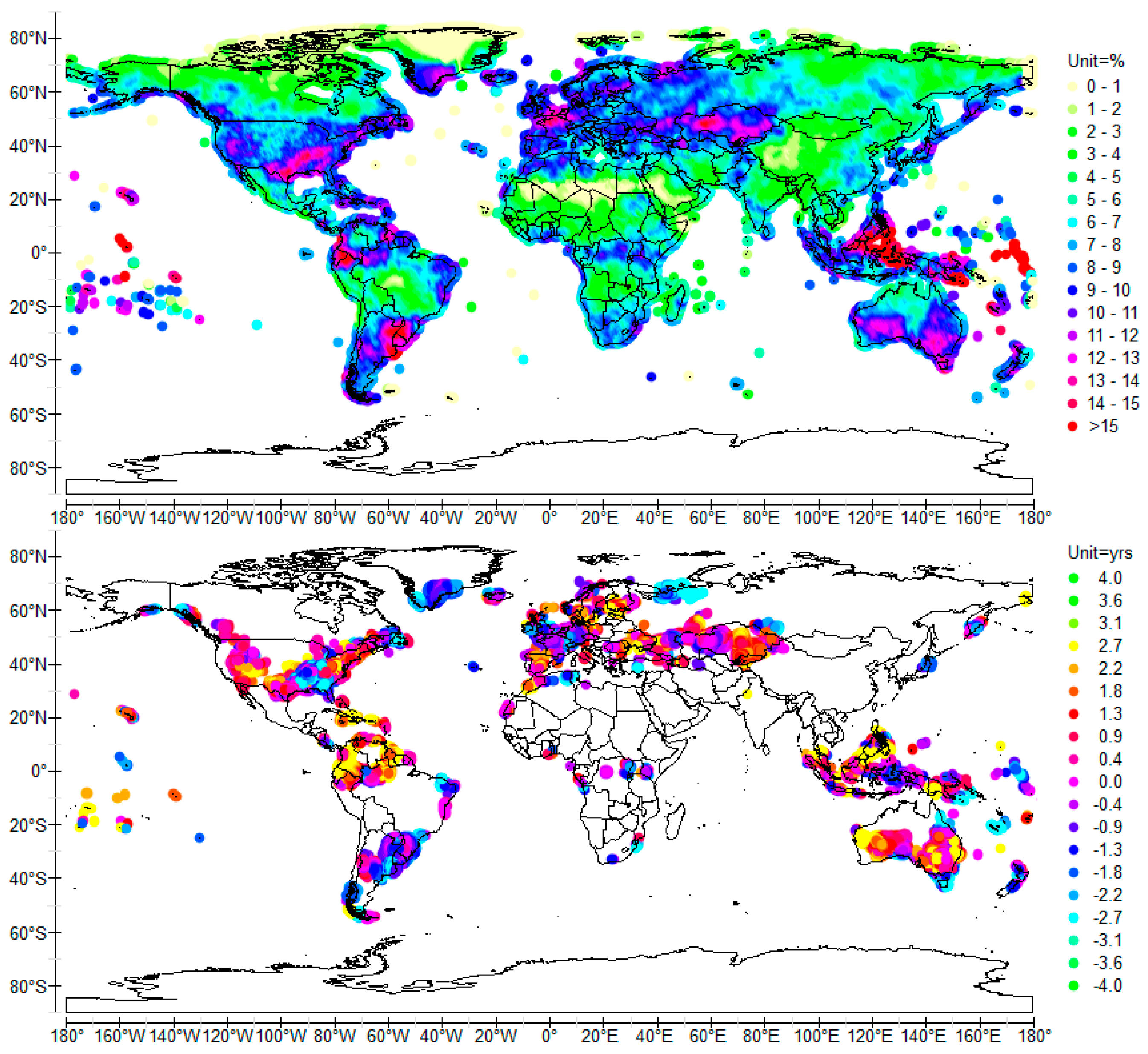
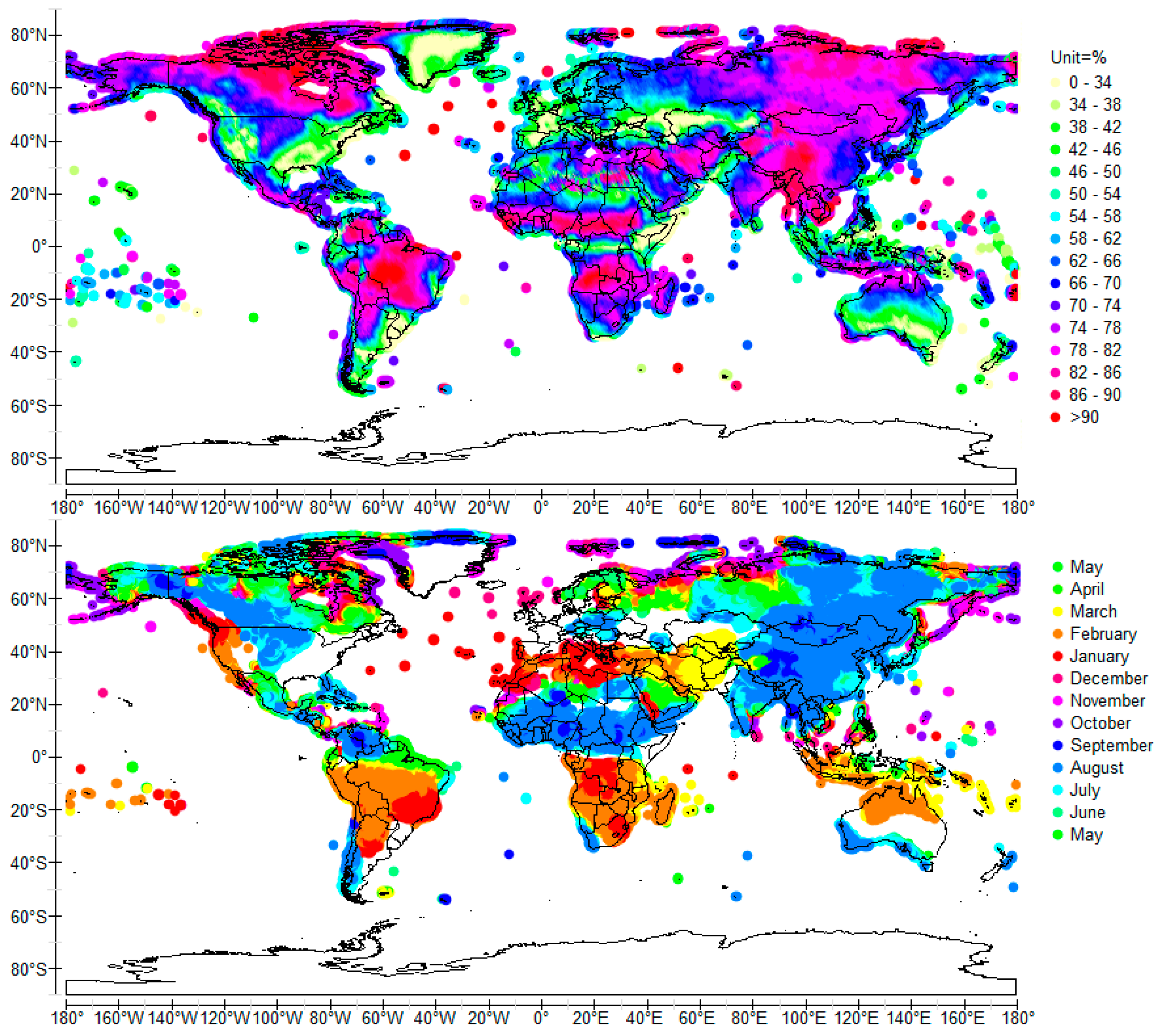
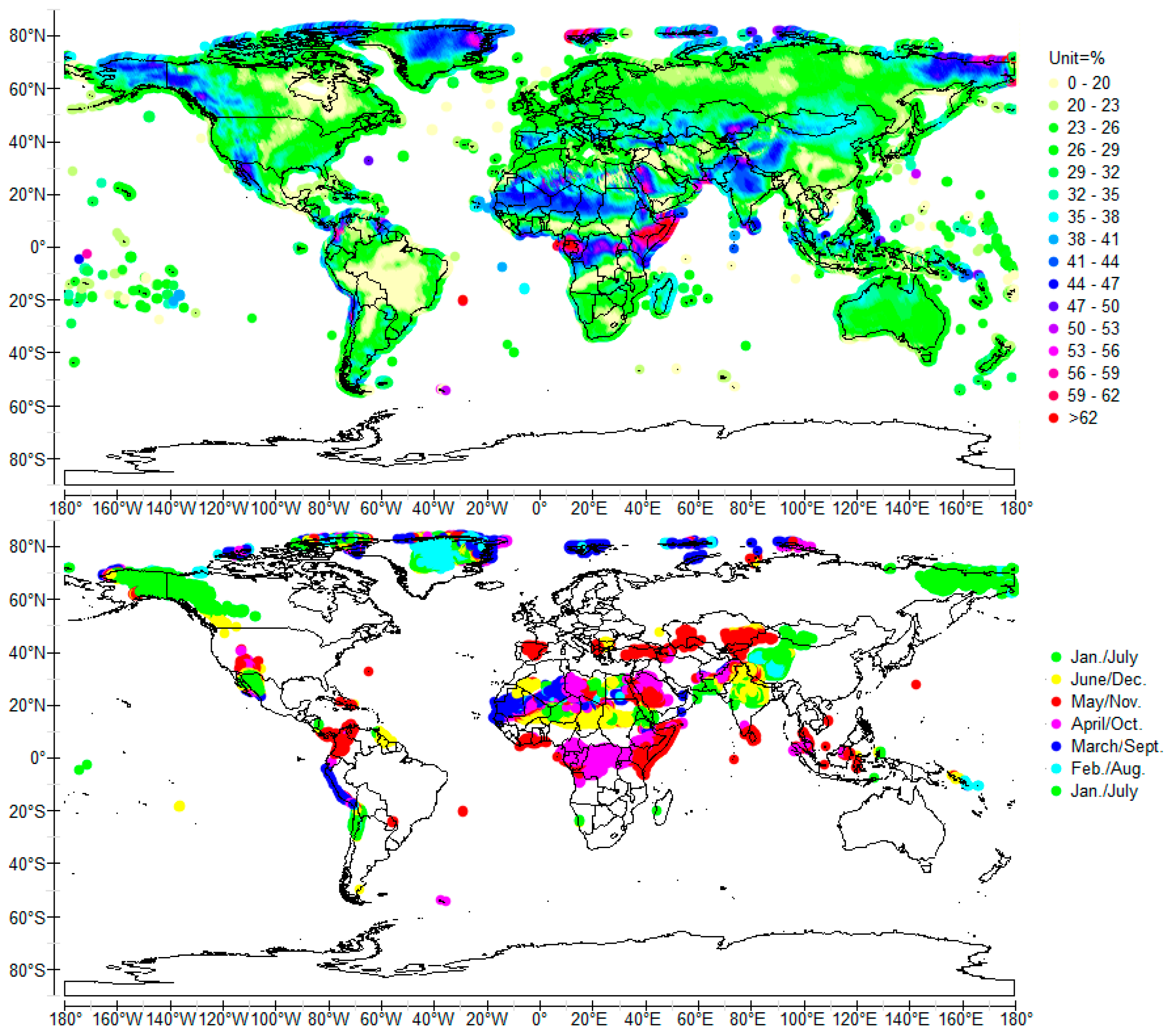

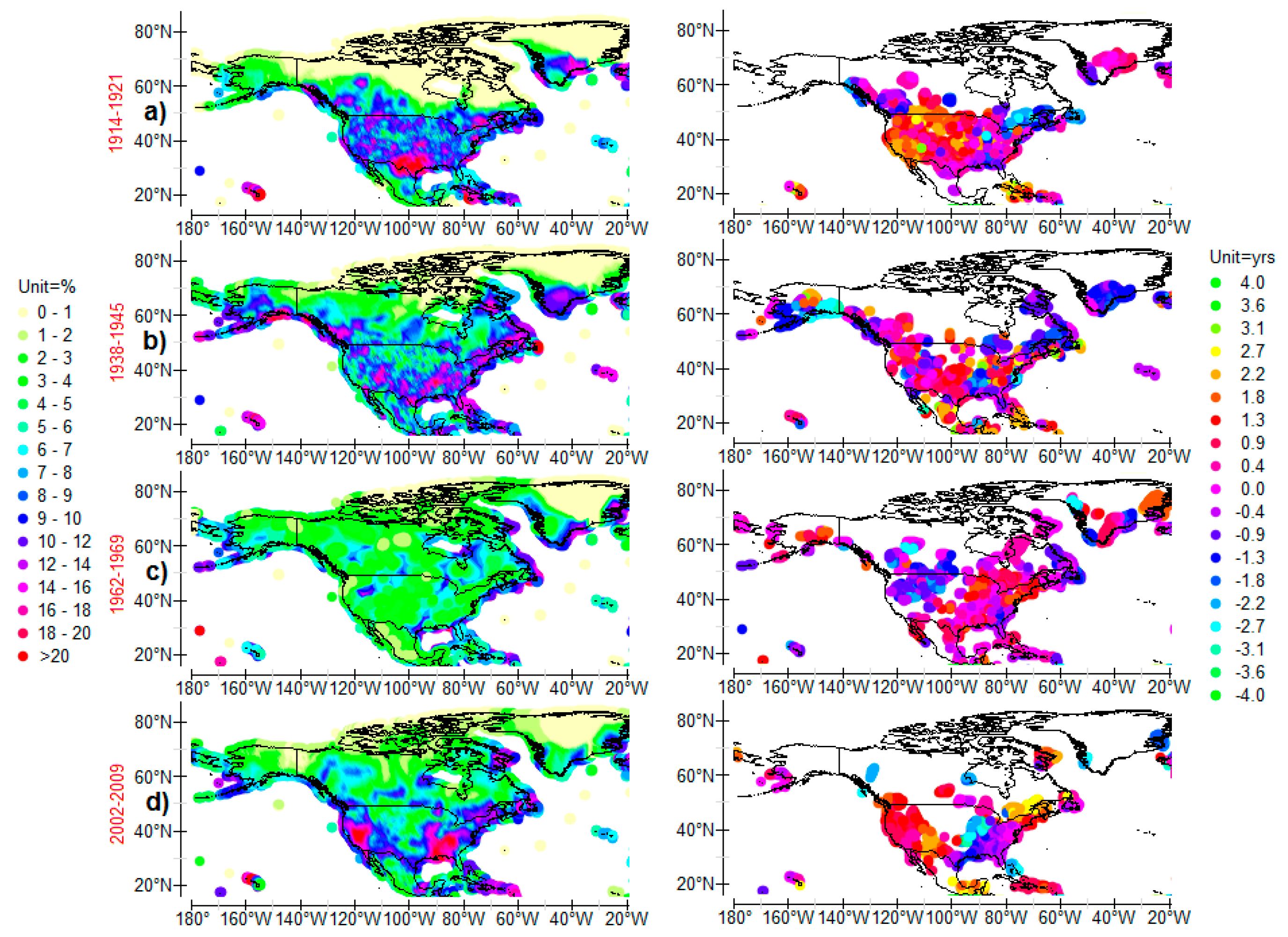
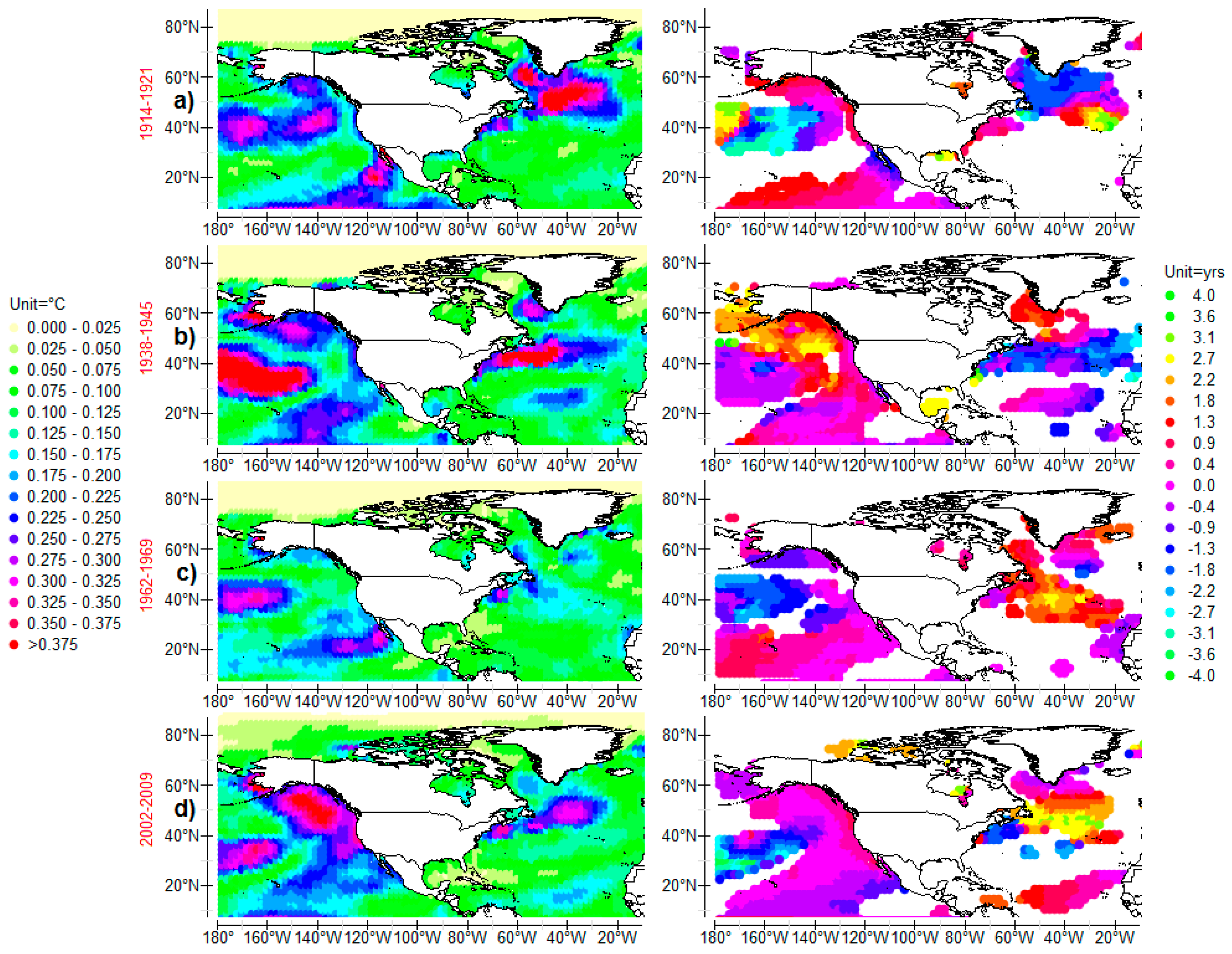
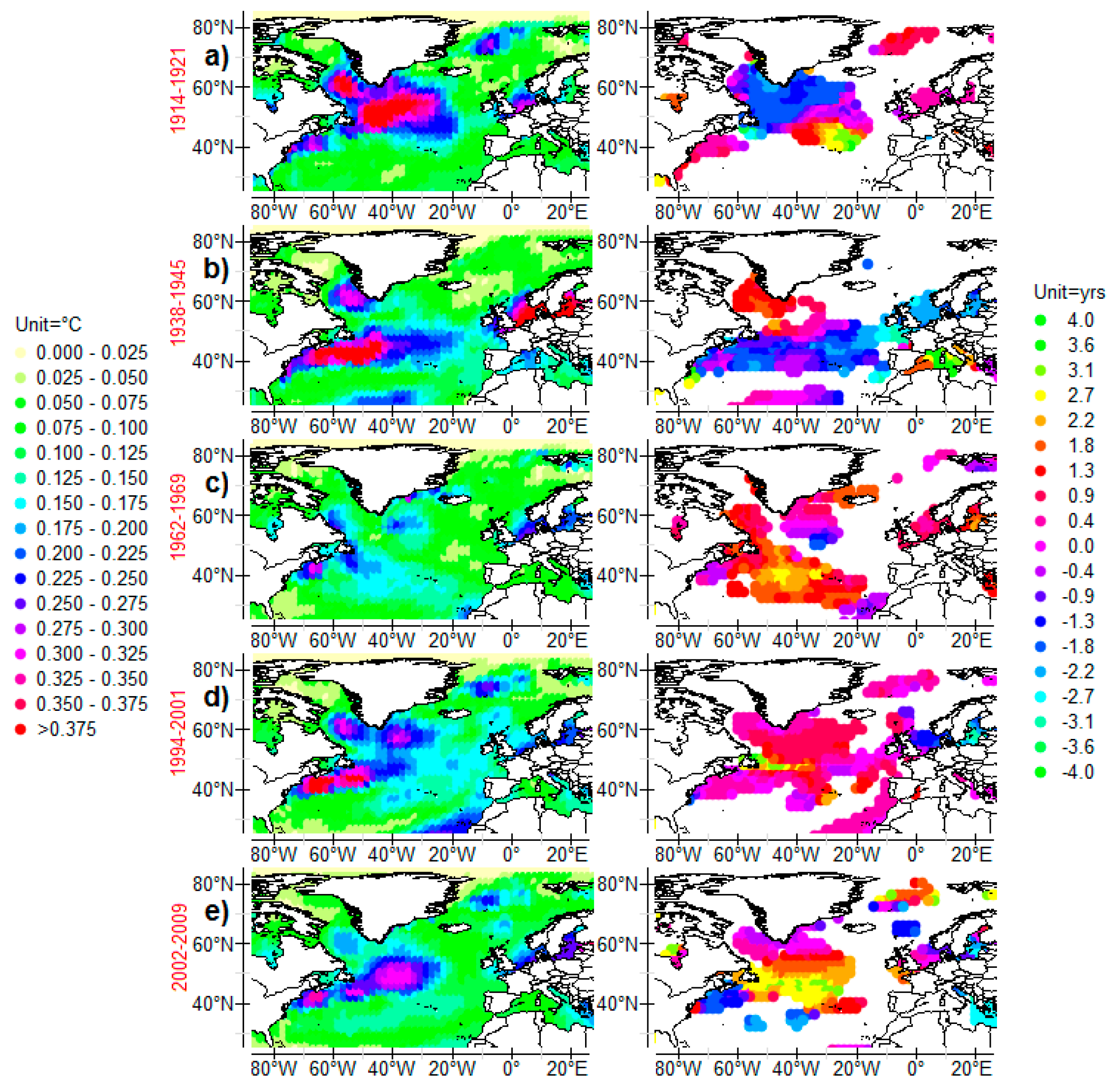
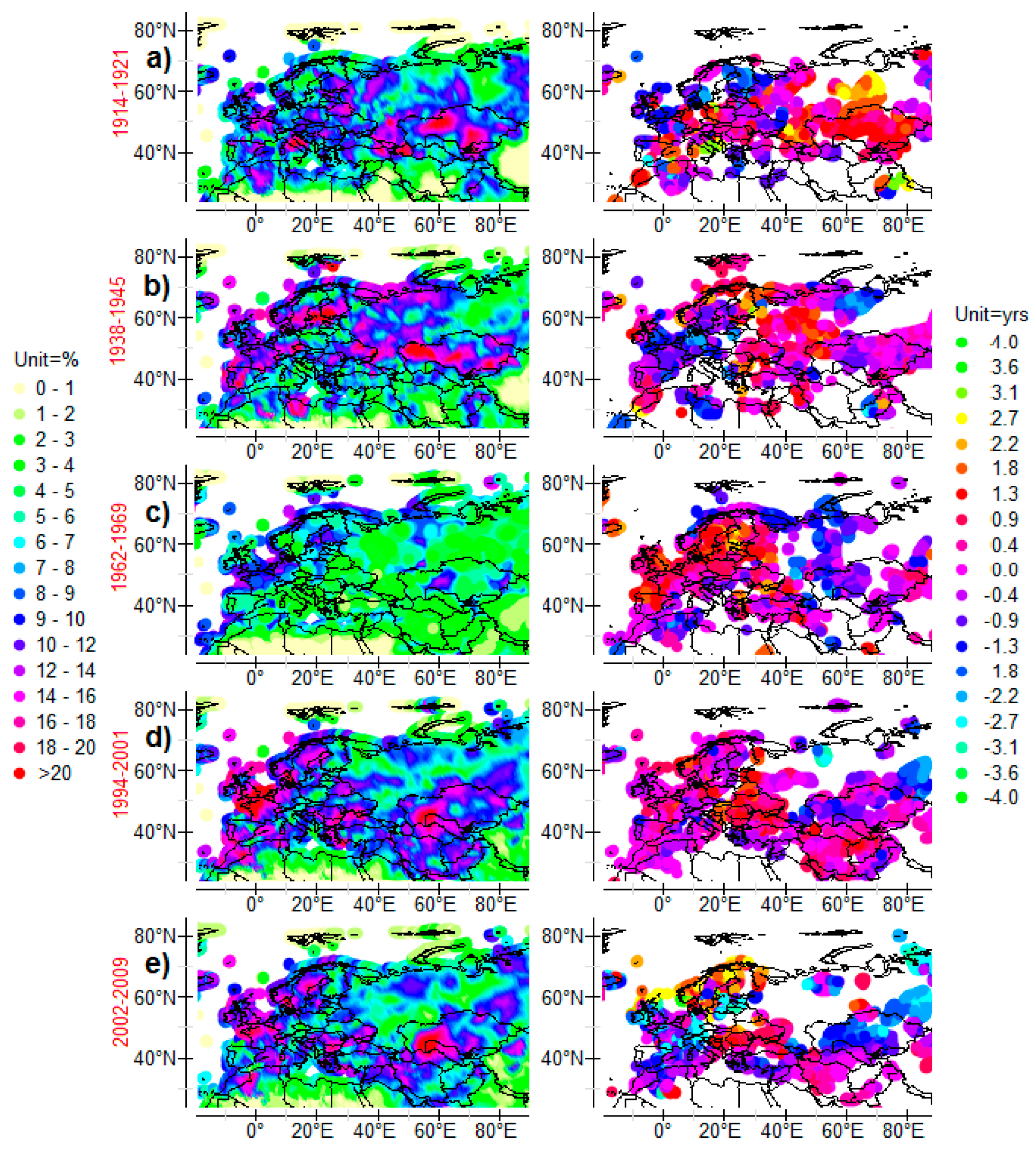

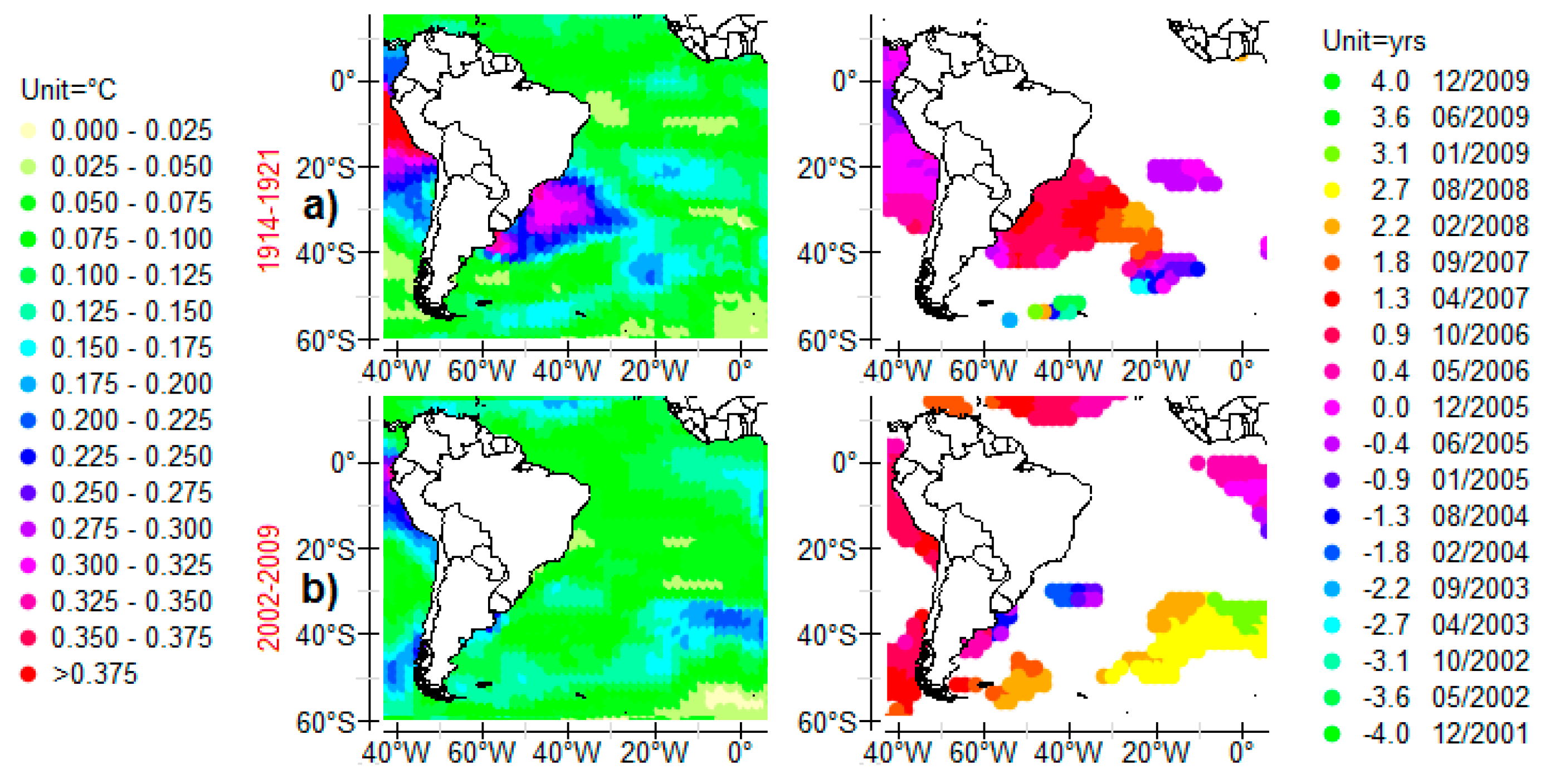

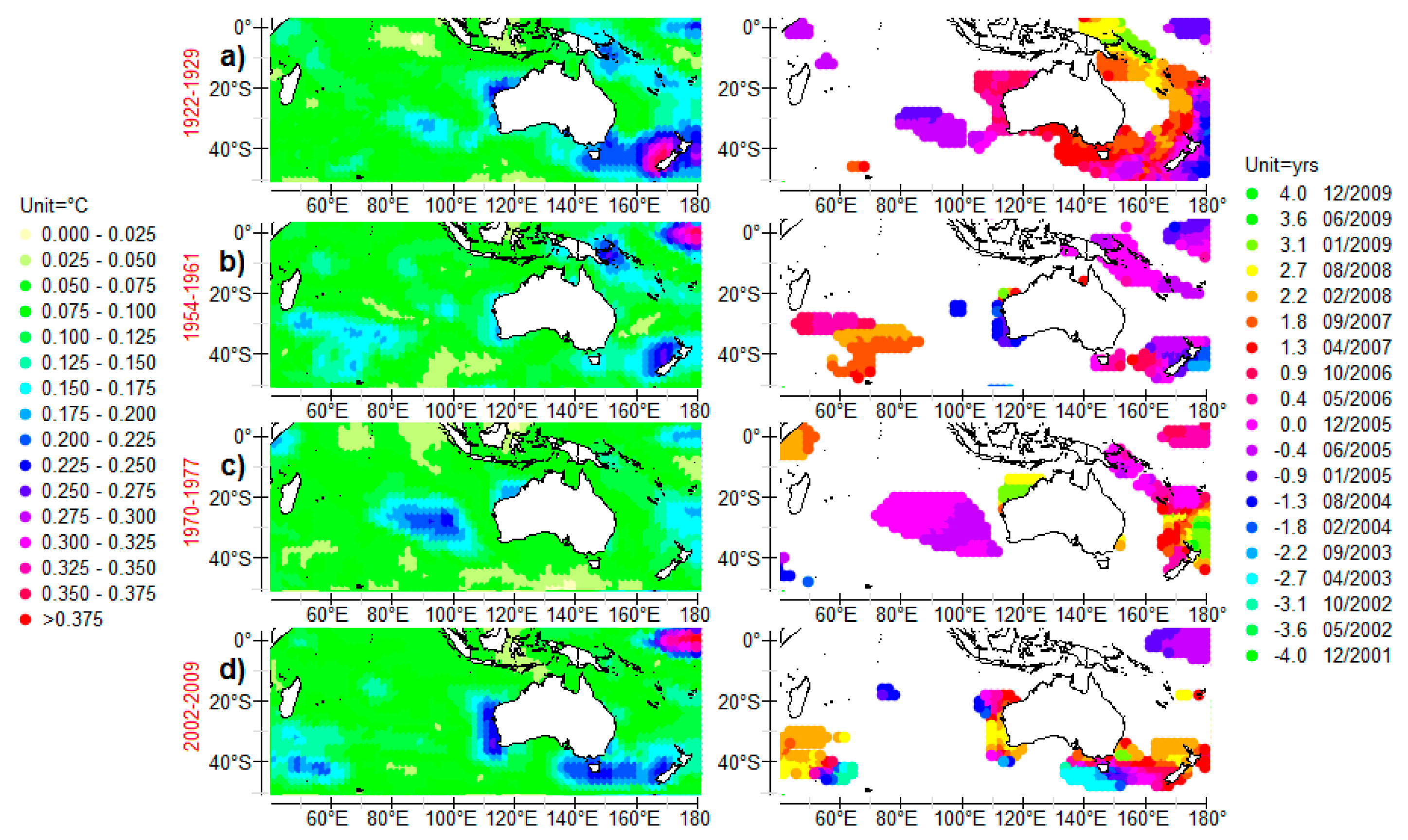

© 2018 by the author. Licensee MDPI, Basel, Switzerland. This article is an open access article distributed under the terms and conditions of the Creative Commons Attribution (CC BY) license (http://creativecommons.org/licenses/by/4.0/).
Share and Cite
Pinault, J.-L. Regions Subject to Rainfall Oscillation in the 5–10 Year Band. Climate 2018, 6, 2. https://doi.org/10.3390/cli6010002
Pinault J-L. Regions Subject to Rainfall Oscillation in the 5–10 Year Band. Climate. 2018; 6(1):2. https://doi.org/10.3390/cli6010002
Chicago/Turabian StylePinault, Jean-Louis. 2018. "Regions Subject to Rainfall Oscillation in the 5–10 Year Band" Climate 6, no. 1: 2. https://doi.org/10.3390/cli6010002




